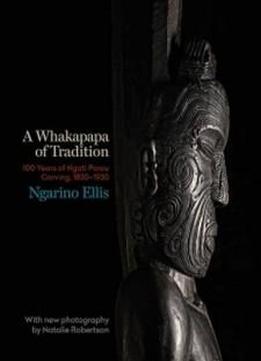
A Whakapapa Of Tradition: One Hundred Years Of Ngato Porou Carving, 1830-1930
by Ngarino Ellis /
2016 / English / EPUB
32.4 MB Download
From the emergence of the chapel and the wharenui in the
nineteenth century to the rejuvenation of carving by Apirana
Ngata in the 1920s, Maori carving went through a rapid evolution
from 1830 to 1930. Focusing on thirty meeting houses, Ngarino
Ellis tells the story of Ngati Porou carving and a profound
transformation in Maori art. Beginning around 1830, three
previously dominant art traditions – waka taua (war canoes),
pataka (decorated storehouses) and whare rangatira (chief’s
houses) – declined and were replaced by whare karakia (churches),
whare whakairo (decorated meeting houses) and wharekai (dining
halls). Ellis examines how and why that fundamental
transformation took place by exploring the Iwirakau School of
carving, based in the Waiapu Valley on the East Coast of the
North Island. What makes a tradition in Maori art? Ellis asks.
How do traditions begin? Who decides this? Conversely, how and
why do traditions cease? And what forces are at play which make
some buildings acceptable and others not? Beautifully illustrated
with new photography by Natalie Robertson, and drawing on the
work of key scholars to make a new synthetic whole, this book
will be a landmark volume in the history of writing about Maori
art.
From the emergence of the chapel and the wharenui in the
nineteenth century to the rejuvenation of carving by Apirana
Ngata in the 1920s, Maori carving went through a rapid evolution
from 1830 to 1930. Focusing on thirty meeting houses, Ngarino
Ellis tells the story of Ngati Porou carving and a profound
transformation in Maori art. Beginning around 1830, three
previously dominant art traditions – waka taua (war canoes),
pataka (decorated storehouses) and whare rangatira (chief’s
houses) – declined and were replaced by whare karakia (churches),
whare whakairo (decorated meeting houses) and wharekai (dining
halls). Ellis examines how and why that fundamental
transformation took place by exploring the Iwirakau School of
carving, based in the Waiapu Valley on the East Coast of the
North Island. What makes a tradition in Maori art? Ellis asks.
How do traditions begin? Who decides this? Conversely, how and
why do traditions cease? And what forces are at play which make
some buildings acceptable and others not? Beautifully illustrated
with new photography by Natalie Robertson, and drawing on the
work of key scholars to make a new synthetic whole, this book
will be a landmark volume in the history of writing about Maori
art.











